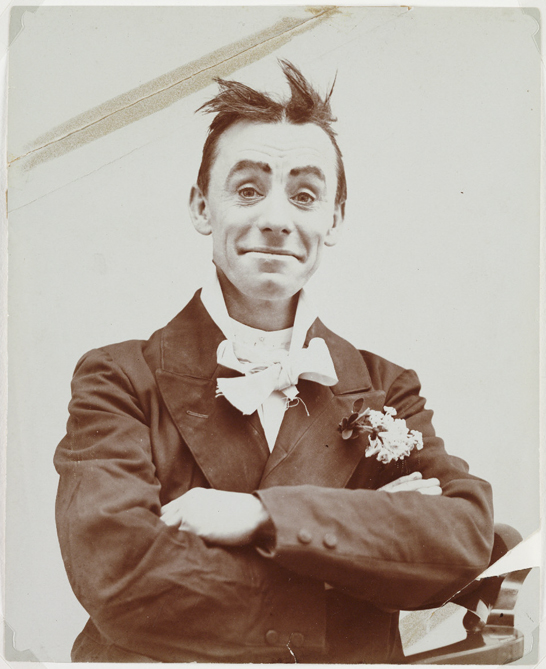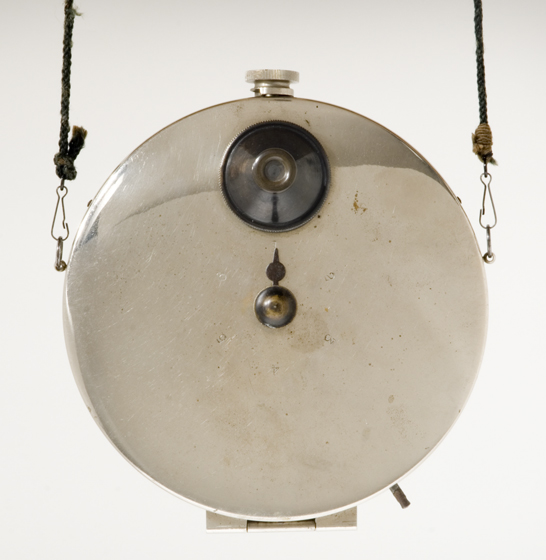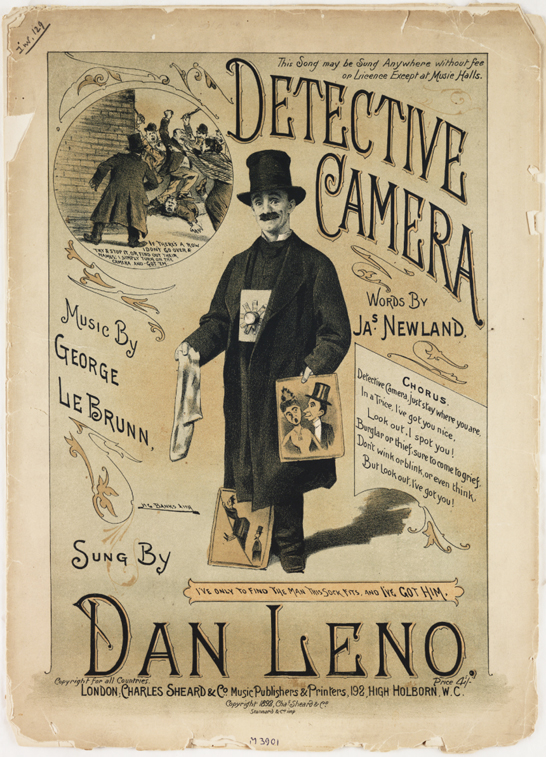Among the thousands of items of ephemera in our collection are a number of Victorian illustrated song sheets. Very attractive in their own right, these also provide a fascinating glimpse into contemporary attitudes to photography. One of my personal favourites is the song sheet for a comic song entitled ‘Detective Camera’.
Published in 1892, with words by James Newland and music by George Le Brunn, ‘Detective Camera’ was performed by one of the greatest music hall artists, Dan Leno. It pokes fun at recent dramatic changes in photographic technology which, for the first time, enabled people to take spontaneous, candid photographs without the subject’s knowledge or permission.

While a small number of hand-held cameras had appeared as early as the 1850s, such cameras were extremely unusual at this time of wet collodion negatives when exposures of several seconds were the general rule. However, the introduction of far more light-sensitive, commercially manufactured gelatine dry plates in the late 1870s made ‘instantaneous’ exposures fully practical for the first time. During the 1880s, cameras designed to be used while hand-held became increasingly popular.
In 1881, Thomas Bolas took out a British patent for a box-form plate camera. Because it could be used in the hand, inconspicuously, he coined the name ‘detective camera’ for his invention. The term came to be applied to almost all hand cameras that appeared up to the end of the century.
Most detective cameras were simple wooden boxes, sometimes covered in leather or even brown paper so as to resemble bags or parcels. Some, however, took things a stage further. During the 1880s several designs for disguised cameras appeared, designed to resemble books or watches or to be hidden in ties, hats or walking sticks.
Some detective cameras relied on concealment rather than disguise. The best-known of these concealed cameras is Stirn’s waistcoat camera—invented by an American but turned into a commercial success by a German.
In December 1885, Robert Gray demonstrated a new camera of his own invention at a meeting of the New York Society of Amateur Photographers. Gray’s ingenious camera was designed ‘to be carried concealed upon the person’ and incorporated, as an integral part, a half-waistcoat or ‘vest’—just like a false ‘dicky’ front worn for evening dress. The camera was hidden behind the waistcoat front with the lens poking through, disguised as a button.
In 1886, after some minor modifications, Gray’s camera was manufactured in America by the Western Electric Company and sold by the Scovill Manufacturing Company. Realising the, as yet untapped, commercial possibilities of the camera, Carl Stirn of New York entered into negotiations to buy the patent rights from Gray.
A suitable deal was struck and in July 1886 Stirn was granted a German patent. Carl’s brother, Rudolf, owned a camera factory in Berlin and by the end of the year had begun production of what was now officially known as ‘CP Stirn’s Patent Concealed Vest Camera’.

Disc-shaped and all metal in construction, at first glance the camera resembles a cross between a frisbee and a hip flask. Thin enough to be worn unobtrusively beneath an ordinary waistcoat, it hung from the photographer’s neck on a strap. The f10, fixed-aperture lens poked through a buttonhole of the waistcoat and, as a further aid to concealment, was designed to look like a button.
Exposures were made on a circular glass plate that was rotated after each exposure by turning a knob protruding from the front of the camera. Six photographs, 40mm in diameter, could be taken on each plate. Rotating the knob also set the rotary shutter, which was released by pulling on a length of string which dangled from the bottom the camera.
Considering its unusual design, the camera was surprisingly popular. By 1890, the manufacturers claimed that no fewer than 18,000 had been sold. Despite its novelty value, contemporary reviewers noted that it was capable of producing quite acceptable results.
One, however, did point out a potential flaw which had more to do with the design of the photographer than with that of the camera:
Persons with a tendency to obesity would have some trouble; they would have to make special arrangements, otherwise they would get nothing but ‘sky’ pictures.

Detective Camera (James Newland / George Le Brunn)
Don’t wink or blink, or even think, but just stay where you are
I’ll introduce myself to you—Detective camera
No matter what you do or say, I’ve got you on the spot
A house on fire’s very warm, you’ll find me twice as hot
(Patter: Hot, I’ve only got to look at a piece of bread, and it’s toasted)
Chorus: Detective Camera, just stay where you are
In a trice I’ve got you nice. Look out, I spot you
Burglar or thief, sure to come to grief
Don’t wink or blink, or even think
But look out, I’ve got you
Last week a loving couple were going to elope
When all were fast asleep, the young man tied a piece of rope
To his sweetheart’s bedroom window, then whistled to his bride
And with her luggage down the rope she then commenced to slide
(Patter: A knot in the rope got me this picture)
Chorus: Detective Camera, just stay where you are
In a trice I’ve got you nice. Look out, I spot you
Burglar or thief, sure to come to grief
Don’t wink or blink, or even think
But look out, I’ve got you.
I saw a sight far from right, ’twould make a parson swear
A fellow in the broad daylight, he kissed a girl so fair
He said he thought it was his wife, said I, ‘You’ll pay for this’
When right before my very eyes he kissed her such a kiss
(Patter: well I never. I have not heard a kiss like that since being vaccinated)
Chorus: Detective Camera, just stay where you are
In a trice I’ve got you nice. Look out, I spot you
Burglar or thief, sure to come to grief
Don’t wink or blink, or even think
But look out, I’ve got you
Great piece but the pics aren’t showing!
Sarah McDonald
Curator, Hulton Archive
Thanks Sarah – spotted it as soon as I hit the publish button… all sorted now!
– Emma
I love this piece – especially the part about some photographers only getting pictures of the sky. Funny that in Sherlock Holmes an obsession with photography dulls ones wits and photographs are used as blackmail. I wonder how many of those cameras were used for blackmail.
チャンルー
Hi,
I have one of these cameras and am looking to sell it. Is this something you guys at the national media museum might be interested in?
many thanks
– George
This camera was produced by my Great Grand Father Carl Paul Stirn. We are so proud of him and his brother. A fantastic family legacy. SStirn